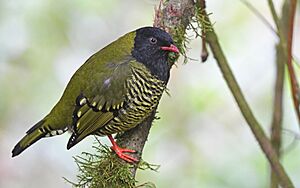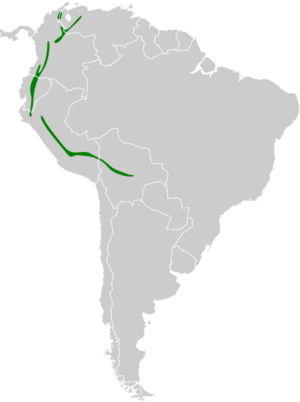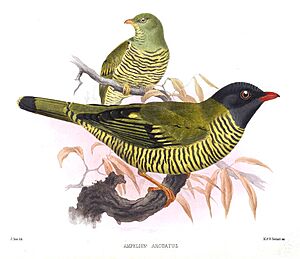Barred fruiteater facts for kids
Quick facts for kids Barred fruiteater |
|
|---|---|
 |
|
| Conservation status | |
| Scientific classification | |
| Genus: |
Pipreola
|
| Species: |
arcuata
|
 |
|
The barred fruiteater (Pipreola arcuata) is a type of bird that lives in the Cotingidae family. You can find these birds in South American countries like Bolivia, Colombia, Ecuador, Peru, and Venezuela. They prefer to live in warm, wet montane forests, which are forests found on mountains. The number of barred fruiteaters is steady, and they are quite common.
Contents
Discover the Barred Fruiteater
This bird is the biggest of all the fruiteaters. It is also the only one that has stripes on its belly, both for males and females. It's a bit plump and moves slowly. An adult barred fruiteater grows to be about 23 cm (9 in) long.
What Does a Male Barred Fruiteater Look Like?
The male bird has a shiny black head and throat. The rest of its upper body is a greenish-brown color. Its tail has black tips, and its wings have large yellow spots. The underside of the male is covered in thin black and pale yellow stripes.
What Does a Female Barred Fruiteater Look Like?
Female barred fruiteaters have a greenish-brown head, throat, and upper body. Their underparts are similar to the males, with black and pale yellow stripes.
Eye Color and Song
Birds living in the northern parts of their range have orange-red eyes. Those in the southern areas have pale gray or olive eyes. Both male and female birds have orange-red legs and beaks. Their song is a soft, high-pitched sound that sounds like "seeeeeeeh".
Where Do Barred Fruiteaters Live?
The barred fruiteater lives in the mountains of South America. Its home stretches from Venezuela, Colombia, and Ecuador down to Peru and Bolivia. These birds live at high altitudes, from about 2,250 to 3,300 metres (7,400 to 10,800 ft) above sea level. This is higher than any other fruiteater species.
How They Travel and Gather
Barred fruiteaters usually move through the forest alone or in pairs. However, if they find a tree with lots of fruit, several birds might gather there to eat.
Conservation Status of the Barred Fruiteater
The Pipreola arcuata species covers a very large area. It is common in many parts of its range. The total area where these birds live is about 259,000 square kilometres (100,000 sq mi). The number of barred fruiteaters seems to be stable. Because of this, the International Union for Conservation of Nature (IUCN) has listed its conservation status as "least concern". This means they are not currently at risk of disappearing.



